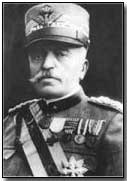Battles - The Battles of the Isonzo, 1915-17
 The battles of the Isonzo were so-named
because they were fought along the Isonzo River on the eastern sector of the
Italian Front between June 1915 and November 1917.
The battles of the Isonzo were so-named
because they were fought along the Isonzo River on the eastern sector of the
Italian Front between June 1915 and November 1917.
The Isonzo is located today in present-day Slovenia. During the First World War however the sixty-mile long river ran north-south just inside Austria along its border with Italy at the head of the Adriatic Sea and then (as now) was flanked by mountains on either side.
Primary Sector for Italian Operations
The only practical area for Italian military operations during the war (the rest of the mountainous 400-mile length of the Front being almost everywhere dominated by Austro-Hungarian forces), the Austrians had taken due care to fortify the mountains ahead of the Italians' long-expected entry into the war on 23 May 1915.
Italian Chief of Staff Luigi Cadorna judged that Italian gains (from Gorizia to Trieste) were most feasible at the coastal plain east of the lower end of the Isonzo. However he also believed that the Italian army could strike further north and bypass the mountains either side of the river so as to come at the Austro-Hungarians in the rear.
Inherent Difficulties of the Isonzo
Not that he expected operations in the Isonzo sector to be easy. He was well aware that the river was prone to flooding - and indeed there were record rain-falls during 1914-18.
Further, when attacking further north the Italian army was faced with something of a dilemma: in order to safely cross the Isonzo they needed to knock out the Austro-Hungarian defenders looking on from the mountains above; yet to neutralise these same forces they needed first to cross the river - an obstacle that the Italians never succeeded in satisfying.
In the south (along the coastal zone) geographic peculiarities, including a collection of ridges and valleys, conspired additionally to work to the Austro-Hungarian defenders' advantage.
Huge Casualties
Despite the huge effort and resources poured into the continuing Isonzo struggle the results were invariably disappointing and without real tactical merit, particularly given the geographic difficulties that were inherent in the campaign. The sector was chosen chiefly because it offered a greater prospect of Italian territorial gain.
Cumulative casualties of the numerous battles of the Isonzo were enormous. Half of the entire Italian war casualty total - some 300,000 of 600,000 - were suffered along the Isonzo. Austro-Hungarian losses, while by no means as numerous were nevertheless high at around 200,000 (of an overall total of around 1.2 million casualties).
10, 11 or 12 Battles?
It is a matter of debate as to just how many battles comprised the Isonzo. Undeniably innumerable one battle often appeared to merge into another. Some historians have assigned distinct names to a couple of the Isonzo struggles, most notably at Caporetto in October 1917, which would otherwise form the Twelfth Battle of the Isonzo.
This website lists Caporetto as both a standalone battle and as the final battle of the Isonzo; thus the twelve battles are listed below. Details of each are available by selecting the appropriate link.
To view maps charting the progress of the campaign fought on the Italian Front click here; and here; and here; and here.
| Battle | Date |
|---|---|
| The First Battle of the Isonzo | 23 June-7 July 1915 |
| The Second Battle of the Isonzo | 18 July-3 August 1915 |
| The Third Battle of the Isonzo | 18 October-3 November 1915 |
| The Fourth Battle of the Isonzo | 10 November-2 December 1915 |
| The Fifth Battle of the Isonzo | 9 March-17 March 1916 |
| The Sixth Battle of the Isonzo | 6 August-17 August 1916 |
| The Seventh Battle of the Isonzo | 14 September-17 September 1916 |
| The Eighth Battle of the Isonzo | 10 October-12 October 1916 |
| The Ninth Battle of the Isonzo | 1 November-4 November 1916 |
| The Tenth Battle of the Isonzo | 12 May-8 June 1917 |
| The Eleventh Battle of the Isonzo | 19 August-12 September 1917 |
| The Twelfth Battle of the Isonzo | 24 October-7 November 1917 |
Photograph courtesy of Photos of the Great War website
A "dope can" was a metal syringe containing petrol for priming an aircraft engine.
- Did you know?
